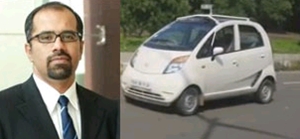TCS techies develop Tata Nano into India’s first driver-less car
16 Mar 2016
Inspired by a near-accident caused by a sleepy cabbie, Roshy John along with some friends have developed India's first driver-less car based on the Tata Nano platform, and are awaiting permission for road tests.

A few years ago, Bengaluru-based techie Roshy John was one his way home from the airport in a taxi when the sleepy driver almost ran into another vehicle. John took over the wheel and drove both the driver and himself home. but experience set him thinking.
Five years later, he and his friends have developed India's first driverless car, the Tata Nano Autonomous.
John, who is practice head, robotics and cognitive systems at Tata Consultancy Services (TCS) and his 29-member team worked on the software and algorithms in their free time and created a 3-D model to test it.
The car is yet to be tested on the road, and John is hoping to get permission from the traffic authorities soon.
In 2011, John purchased a Nano to test the software. "The Tata Nano is considered an engineering marvel. What better car to test Indian technology than on a car made in India," he says.
Across the world, Daimler, Nissan, General Motors, BMW, Google, Apple and Tesla are investing big money in developing driverless cars.
John used onboard diagnostics, a regular feature in most cars today, and a scanner to monitor the engine. "I had to get data from the car to make it accelerate or slow down based on the RPM," he explains.
Creating an algorithm using a custom cluster (multiple computers), John and his team were able to read all parameters of the engine.
Several other devices were used to extract vitals of the car and its surroundings wheel encoders to measure the speed of the wheel, multiple lidars (a surveying technology that measures distance by illuminating a target with a laser light) to identify obstacles around the car,
HDR cameras and GPS. The data was processed by the software to make the car 'drive' like a human.
He attached pedal robots to the accelerator, brake and clutch and connected them to the software. The ultimate test for the team was when the car halted by itself when John jumped in front of it. In May 2012, John's autonomous car drove the roads of Bengaluru for the first time.
John's journey wasn't easy though. They were often interrogated by the police, who got suspicious about the cameras and many computers in the car.
To import the scanners, John had to submit a three-page essay to the commissioner of customs before he was given his package. Amidst work responsibilities and project deadlines, John and his team have been at work on the autonomous Nano.
So what is the way ahead for John and his driverless car? A demo event for people to experience the technology will be scheduled soon. Having invested more than Rs 1 crore on the research, he is testing the technology on other cars.
While John has been approached by several auto companies, he has kept the offers at bay. "Right through my career, I have encouraged my team members to experiment with advanced technology. I built this car to satiate my hunger for innovation in robotics and inspire others," he says.





















